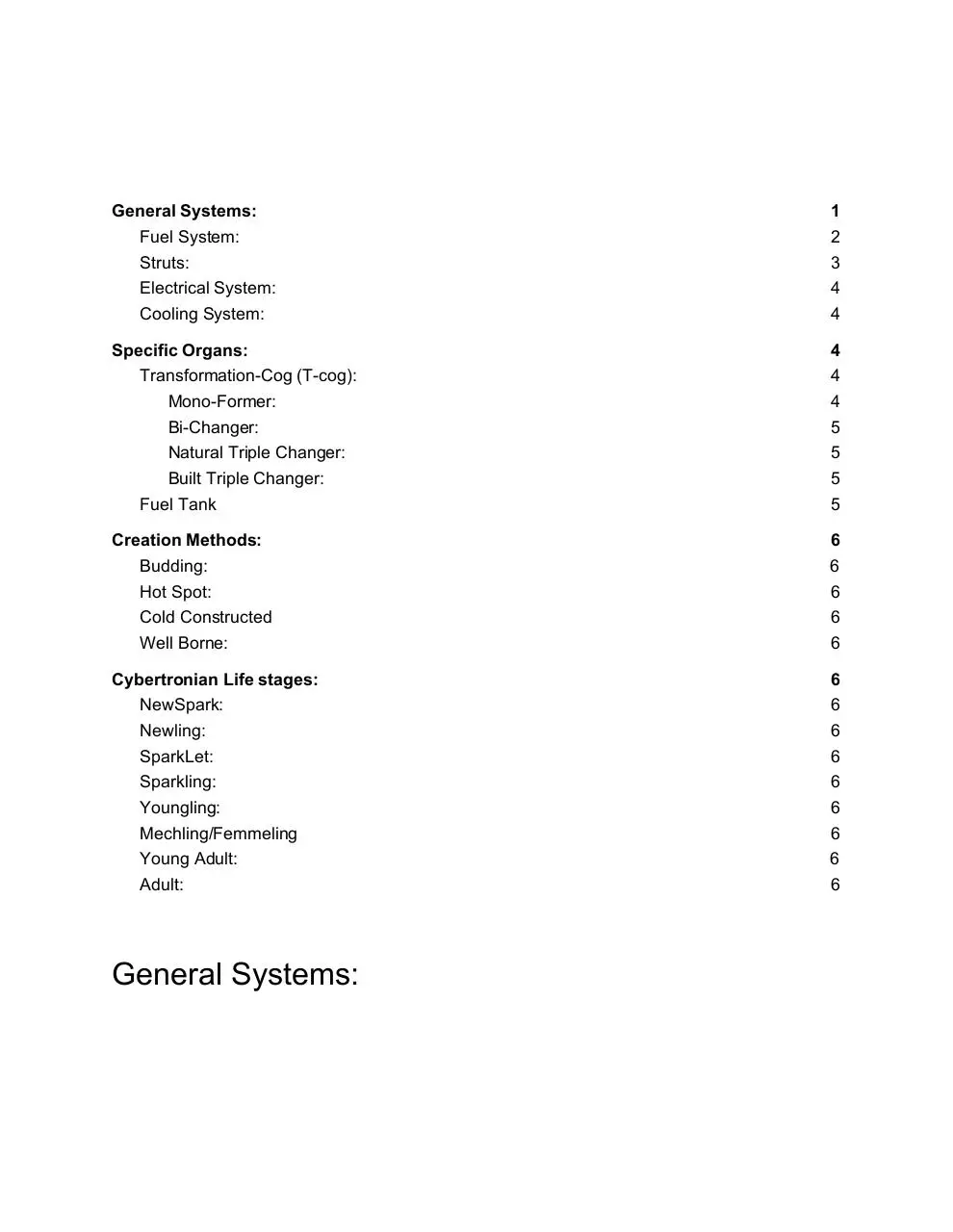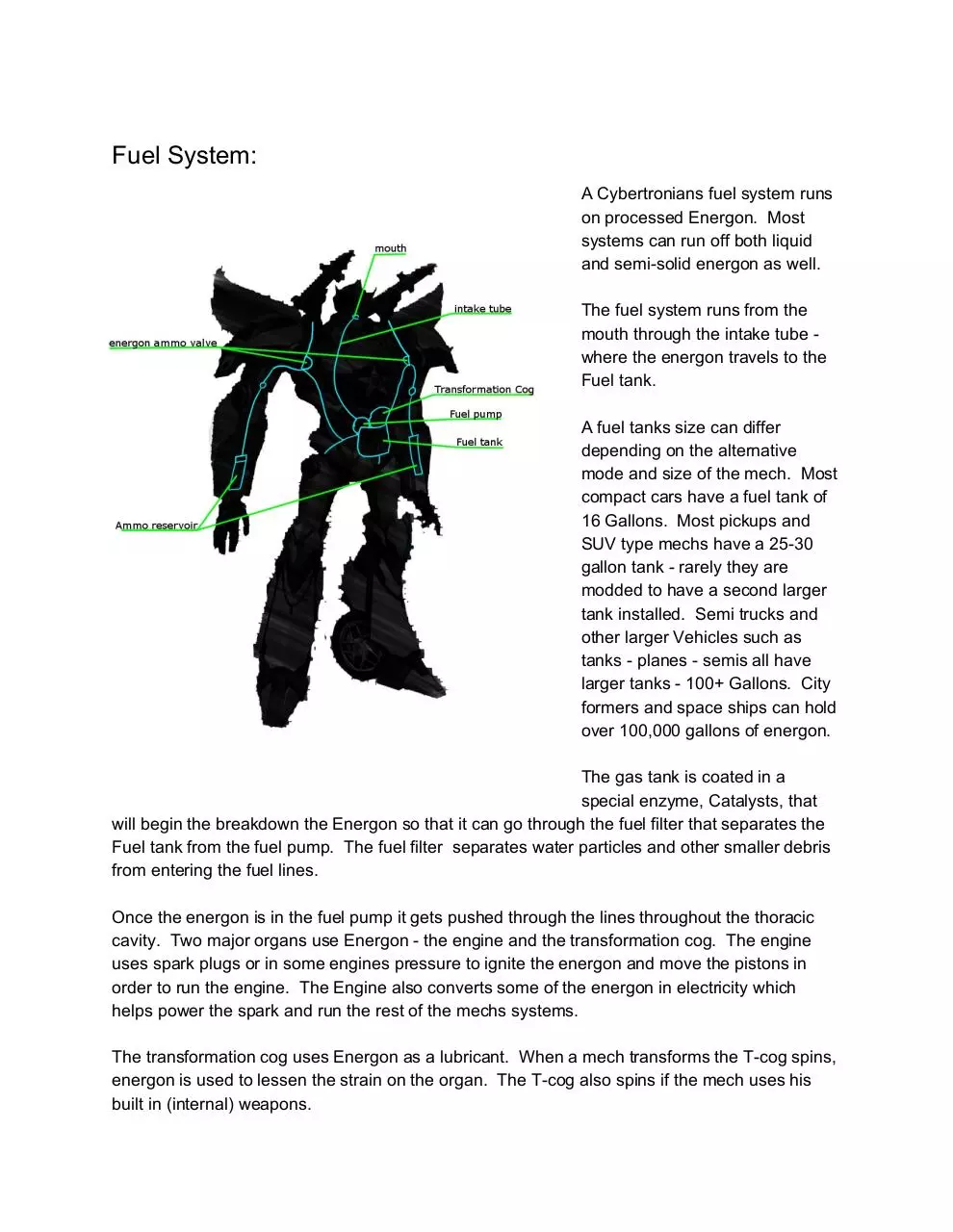Cybertron Medical Manual (1) (PDF)
File information
This PDF 1.5 document has been generated by / Skia/PDF m62, and has been sent on pdf-archive.com on 01/09/2017 at 17:14, from IP address 24.236.x.x.
The current document download page has been viewed 353 times.
File size: 179.58 KB (7 pages).
Privacy: public file





File preview
General Systems:
1
Fuel System:
2
Struts:
3
Electrical System:
4
Cooling System:
Specific Organs:
Transformation-Cog (T-cog):
4
4
4
Mono-Former:
4
Bi-Changer:
5
Natural Triple Changer:
5
Built Triple Changer:
Fuel Tank
Creation Methods:
5
5
6
Budding:
6
Hot Spot:
6
Well Borne:
6
Cold Constructed
Cybertronian Life stages:
6
6
NewSpark:
6
Newling:
6
SparkLet:
6
Sparkling:
6
Youngling:
6
Mechling/Femmeling
6
Young Adult:
6
Adult:
General Systems:
6
Fuel System:
A Cybertronians fuel system runs
on processed Energon. Most
systems can run off both liquid
and semi-solid energon as well.
The fuel system runs from the
mouth through the intake tube where the energon travels to the
Fuel tank.
A fuel tanks size can differ
depending on the alternative
mode and size of the mech. Most
compact cars have a fuel tank of
16 Gallons. Most pickups and
SUV type mechs have a 25-30
gallon tank - rarely they are
modded to have a second larger
tank installed. Semi trucks and
other larger Vehicles such as
tanks - planes - semis all have
larger tanks - 100+ Gallons. City
formers and space ships can hold
over 100,000 gallons of energon.
The gas tank is coated in a
special enzyme, Catalysts, that
will begin the breakdown the Energon so that it can go through the fuel filter that separates the
Fuel tank from the fuel pump. The fuel filter separates water particles and other smaller debris
from entering the fuel lines.
Once the energon is in the fuel pump it gets pushed through the lines throughout the thoracic
cavity. Two major organs use Energon - the engine and the transformation cog. The engine
uses spark plugs or in some engines pressure to ignite the energon and move the pistons in
order to run the engine. The Engine also converts some of the energon in electricity which
helps power the spark and run the rest of the mechs systems.
The transformation cog uses Energon as a lubricant. When a mech transforms the T-cog spins,
energon is used to lessen the strain on the organ. The T-cog also spins if the mech uses his
built in (internal) weapons.
Usually Energon lines only run throughout the thoracic cavity - the limbs alone having little to no
use for energon. Only smaller vessels running under the panels to supply energon to color
nanites.
If a mech has weapons installed internally and they use energon as ammo a valve should be
installed between the thoracic cavity and the limb with the weapon. This valve is a safety
feature installed when they have the internal weapon installed, this safety feature can be
overridden. This valve will open either on command or automatically when the ammo reservoir
is empty. If the mech hasn’t had enough energon the valve will not fill with energon and the
weapon will be out of ammo.
Struts:
The struts are the main ‘backbone’ that keeps a mech upright and his frame together. Struts
are most commonly exposed as the upper arms, inner thigh, and most joint areas. Struts are
generally strong and can withstand a lot of punishment. Some Struts are thicker than others
and if a strut is broken or becomes detached there can be some pain involved. Having a limb
removed at the joint is generally an easier issue than having the limb removed mid strut.
If a strut should happen to break or be torn off usually all a medic would need to do is weld it
back together, sand down the seam, and paint over it with a Rustoleum primer. Then the
Patient should return in a few days to have the coverings and protective plating removed.
The Spinal Struts are the “backbone”. These struts have either air filled bags or energon filled
bags to help cushion the disk like structures from each other while a mechs moves and goes
about their day. These air filled/fluid filled bladders protect the disks from scraping one another.
The Disks themselves are typically half the size of the mechs fists. About ⅓ of the disks total
area is taken up by a wiring canal that leads up from the base of the hip struts to the base of the
helm. Typically there are 13 disks that make up a mechs back struts. Mecha with extra back
appendages (Wings, doorwings, certain kinds of kibble) will often have a second back strut
rather than just one. The back struts will then combine into one closer to the helm and when the
appendages have been cleared.
Triple changers, Cybertronians with one root mode and two other alternative modes) require
much more flexible struts since they have two alternative modes to accommodate. It is more
likely for a triple changer to be double jointed rather than a bi-changer (Cybertronian with only a
root mode and an alternative mode) as well. There will also likely be more joints along the
struts in a triple changer rather than a bi-changer.
Electrical System:
Cooling System:
Specific Organs:
Transformation-Cog (T-cog):
The T-Cog is the organ that gives a Cybertronian the ability to Transform. This organ also
allows a Cybertronian to access and fire integrated weaponry (Weaponry installed into their
frame and uses their own energon as ammo).
During Transformation the T-cog spins. While the T-cog spins it sends out information to the
rest of the mecha’s frame and it will begin to shift panels and parts until the Transformation is
complete.
There are two main parts to a T-cog - the Belt and the Gear. The Belt has “teeth” that connect
to the gears teeth and it spins with the belt.
There are two types of Triple-changers - The Natural Triple Changer meaning they are born with
a mutated T-cog then there is the Built Triple changer - Where they added another T-cog to their
system so they could change into a third (and possibly fourth) mode.
The T-cog isn’t always active and functional, Well born mecha are born with their T-cogs intact.
Budded Mecha are not. When budded mecha emerge the T-cog is underdeveloped and needs
more time to complete the formation of the internal mechanisms of the organ. Usually by the
third week after emergence (So long as they have developed normally) they can start
transforming into their first alt mode - usually a ball of some kind.
Mono-Former:
Mono-formers are Cybertronians who either electected to have their Transformation cogs
removed (ex: Religion, Disease, etc.). These Cybertronians cannot change form. They are
stuck in Bi-pedal mode and they do not have access to integrated weaponry.
Bi-Changer:
Bi-Changers are Cybertronian-kinds most common characteristic. There have been studies
stateing that socially Cybertronians are more accepted as long as they can transform into
something.
The way these T-cogs work is that the t cog moves on only two directions. One way allows for
Transformation into Root mode and the opposite way makes for Transformation in the
Alternative mode. In normal cases The T-cog spins horizontally.
Natural Triple Changer:
Natural Triple Changers are mecha with one T-cog and three directions to Transform. This third
Direction has been known to differ on different mecha, sometimes the second “belt” is only
slightly off from the horizontal belt sometimes it runs perpendicular most are at varying angle
degrees between 15 and 80 degrees.
Depending on how the t-cog mutated there could either be two belts and one gear or there
could be two belts and two gears. No one is actually sure why such mutations actually occur
but it happens.
Built Triple Changer:
Built Triple changers are mecha that were sparked with only a bi-changer t-cog. There is an
option that allows bi-changers to acquire a third alternative mode (and theoretically a fourth,
fifth, etc.). Installing another T-cog. Theoretically a mecha can have any number of t-cogs
installed so long as they had the space for them.
With having more than one t-cog installed there is a major energon drain because T-cogs use
energon as lubricant. And it will need to go to BOTH t-cogs.
Fuel Tank
Creation Methods:
Budding:
Hot Spot:
Cold Constructed
Well Borne:
Cybertronian Life stages:
NewSpark:
Newling:
SparkLet:
Sparkling:
Youngling:
Mechling/Femmeling
Young Adult:
Adult:
Diseases/Conditions:
Anemia:
Fords Joint Disease:
T-Cog Degradation:
Credit:
Rules and Protocol
Elitaxne
Weaponized Defribullator
AutobotWheelie
Download Cybertron Medical Manual (1)
Cybertron Medical Manual (1).pdf (PDF, 179.58 KB)
Download PDF
Share this file on social networks
Link to this page
Permanent link
Use the permanent link to the download page to share your document on Facebook, Twitter, LinkedIn, or directly with a contact by e-Mail, Messenger, Whatsapp, Line..
Short link
Use the short link to share your document on Twitter or by text message (SMS)
HTML Code
Copy the following HTML code to share your document on a Website or Blog
QR Code to this page

This file has been shared publicly by a user of PDF Archive.
Document ID: 0000667413.